Assessment of Seawater Intrusion in Coastal Aquifers Using Multivariate Statistical Analyses and Hydrochemical Facies Evolution-Based Model
Abstract
:1. Introduction
2. Materials and Methods
2.1. Study Area
2.2. Sampling and Physico-Chemical Analyses
2.3. Statistical and Geospatial Analyses
2.4. Seawater Intrusion Indicators
2.4.1. Chadha’s Diagram
2.4.2. Correlation between Hydrochemical Parameters
2.5. Hydrochemical Facies Evolution (HFE) Diagram
3. Results and Discussion
3.1. Statistical Results
3.2. Water Chemical Features
3.3. Seawater Intrusion Indicators
Correlation between Cl and Ca/Mg Ratio
3.4. Hydrochemical Facies Evolution (HFE) Diagram Results
3.5. Mixture with Seawater Estimation
4. Conclusions
Author Contributions
Funding
Institutional Review Board Statement
Informed Consent Statement
Data Availability Statement
Acknowledgments
Conflicts of Interest
Abbreviations
| HFE | Hydrochemical facies evolution |
| EC | Electrical conductivity |
| FAHP | Fuzzy analytical hierarchy process |
| FR | Frequency ratio |
| GIS | Geographic information system |
| GW | Groundwater |
| GWQ | Groundwater quality |
| GWP | Groundwater potential |
| GWL | Groundwater level |
| HCA | Hierarchic cluster analysis |
| IDW | Inverse distance weighted |
| IB | Ion balance |
| KMO | Kaiser–Meyer–Olkin |
| MCA | Multiple correspondent analysis |
| RCAD-Sfax | Regional Commissariat of Agricultural Development of Sfax |
| Rmix | Mixing ratio |
| SWI | Seawater intrusion |
| PCA | Principal component analysis |
| WOE | Weights of evidence models |
References
- Boukari, M.; Gaye, C.B.; Faye, A.; Faye, S. The impact of urban development on coastal aquifers near Cotonou, Benin. J. Afr. Earth Sci. 1996, 22, 403–408. [Google Scholar] [CrossRef]
- Koussis, A.D.; Kotronarou, A.; Destouni, G.; Prieto, C. Intensive groundwater development in coastal zones and small islands. In Intensive Use of Groundwater: Challenges and Opportunities; Llamas, R., Custodio, E., Eds.; Balkema: Lisse, The Netherlands, 2003; Chapter 6. [Google Scholar]
- Faye, S.C.; Faye, S.; Wohnlich, S.; Gaye, C.B. An assessment of the risk associated with urban development in the Thiaroye area (Senegal). Environ. Geol. 2004, 45, 312–322. [Google Scholar] [CrossRef]
- Nejib, S.; Mehdi, K.; Riss, J.; Fadili, A.; Pulido-Bosch, A.; Guessir, H. Salinisation de l’aquifère libre de la Chaouia côtière (Azemmour-Tnine Chtouka), Maroc. Hydrol. Sci. J. 2017, 62, 749–759. [Google Scholar] [CrossRef]
- Chidambaram, S.; Sarathidasan, J.; Srinivasamoorthy, K.; Thivya, C.; Thilagavathi, R.; Prasanna, M.V.; Singaraja, C.; Nepolian, M. Assessment of hydrogeochemical status of groundwater in a coastal region of Southeast coast of India. Appl. Water Sci. 2018, 8, 27. [Google Scholar] [CrossRef] [Green Version]
- Dinka, M.O.; Loiskandl, W.; Ndambuki, J.M. Hydrochemical characterization of various surface water and groundwater resources available in Matahara areas, Fantalle Woreda of Oromiya region. J. Hydrol. Reg. Stud. 2015, 3, 444–456. [Google Scholar] [CrossRef] [Green Version]
- Sun, X.; Zhang, H.; Zhong, M.; Wang, Z.; Liang, X.; Huang, T.; Huang, H. Analyses on the Temporal and Spatial Characteristics of Water Quality in a Seagoing River Using Multivariate Statistical Techniques: A Case Study in the Duliujian River, China. Int. J. Environ. Res. Public Health 2019, 16, 1020. [Google Scholar] [CrossRef] [PubMed] [Green Version]
- Barkat, A.; Bouaicha, F.; Bouteraa, O.; Mester, T.; Ata, B.; Balla, D.; Rahal, Z.; Szabó, G. Assessment of Complex Terminal Groundwater Aquifer for Different Use of Oued Souf Valley (Algeria) Using Multivariate Statistical Methods, Geostatistical Modeling, and Water Quality Index. Water 2021, 13, 1609. [Google Scholar] [CrossRef]
- Alfaifi, H.J. Combined graphical and geostatistical technique to determine the hydrochemical processes affecting groundwater chemistry in coastal areas, Western Saudi Arabia. Arab. J. Geosci. 2019, 12, 65. [Google Scholar] [CrossRef]
- Machiwal, D.; Jha, M.K. Identifying sources of groundwater contamination in a hard-rock aquifer system using multivariate statistical analyses and GIS-based geostatistical modeling techniques. J. Hydrol. Reg. Stud. 2015, 4, 80–110. [Google Scholar] [CrossRef] [Green Version]
- Hajji, S.; Bouri, S.; Hachicha, W.; Ben Dhia, H. Implementation and evaluation of multivariate analysis for groundwater hydrochemistry assessment in arid environments: A case study of Hajeb Elyoun–Jelma, Central Tunisia. Environ. Earth Sci. 2013, 70, 2215–2224. [Google Scholar]
- Hajji, S.; Ayed, B.; Riahi, I.; Allouche, N.; Boughariou, E.; Bouri, S. Assessment and mapping groundwater quality using hybrid PCA-WQI model: Case of the Middle Miocene aquifer of Hajeb Layoun-Jelma basin (Central Tunisia). Arab. J. Geosci. 2018, 11, 620. [Google Scholar] [CrossRef]
- Ren, C.; Zhang, Q. Groundwater Chemical Characteristics and Controlling Factors in a Region of Northern China with Intensive Human Activity. Int. J. Environ. Res. Public Health 2020, 17, 9126. [Google Scholar] [CrossRef] [PubMed]
- Zhang, Q.; Wang, L.; Wang, H.; Zhu, X.; Wang, L. Spatio-temporal variation of groundwater quality and source apportionment using multivariate statistical techniques for the Hutuo River alluvial-pluvial fan, China. Int. J. Environ. Res. Public Health 2020, 17, 1055. [Google Scholar] [CrossRef] [PubMed] [Green Version]
- Kura, N.U.; Ramli, M.F.; Sulaiman, W.N.A.; Ibrahim, S.; Aris, A.Z.; Mustapha, A. Evaluation of factors influencing the groundwater chemistry in a small tropical island of Malaysia. Int. J. Environ. Res. Public Health 2013, 10, 1861–1881. [Google Scholar] [CrossRef] [Green Version]
- Guo, Q.; Zhao, Y.; Hu, Z.; Li, M. Contamination Transport in the Coastal Unconfined Aquifer under the Influences of Seawater Intrusion and Inland Freshwater Recharge—Laboratory Experiments and Numerical Simulations. Int. J. Environ. Res. Public Health 2021, 18, 762. [Google Scholar] [CrossRef] [PubMed]
- Wen, Y.; Qiu, J.; Cheng, S.; Xu, C.; Gao, X. Hydrochemical Evolution Mechanisms of Shallow Groundwater and Its Quality Assessment in the Estuarine Coastal Zone: A Case Study of Qidong, China. Int. J. Environ. Res. Public Health 2020, 17, 3382. [Google Scholar] [CrossRef] [PubMed]
- Vahidipour, M.; Raeisi, E.; Van Der Zee, S.E. Active saltwater intrusion of shrinking Bakhtegan-Thask Lakes in South Iran threatens the freshwater resources of coastal aquifers. J. Hydrol. Reg. Stud. 2021, 34, 100790. [Google Scholar] [CrossRef]
- Foster, S.S.D.; Tyson, G.; Voss, C.; MacDonald, A.M.; Aureli, A.; Aggarwal, P. Global Change and Groundwater; International Association of Hydrogeologists, 6pp. (Strategic Overview Series); International Association of Hydrogeologists: Reading, UK, 2016; 6p. [Google Scholar]
- Dörfliger, N.; Augeard, B. Mapping Techniques and Hydrogeological Models to Characterise Seawater Intrusion in French Coastal Aquifers and Assess the Potential Impact of Sea-Level Rise. 2013. Available online: https://professionnels.ofb.fr/sites/default/files/en/doc/documentation/KFA2013_SeawaterIntrusion_Aquifer.pdf (accessed on 15 July 2021).
- Boughariou, E.; Allouche, N.; Ben Brahim, F.; Nasri, G.; Bouri, S. Delineation of groundwater potentials of Sfax region, Tunisia, using fuzzy analytical hierarchy process, frequency ratio, and weights of evidence models. Environ. Dev. Sustain. 2021, 23, 14749–14774. [Google Scholar] [CrossRef]
- Boughariou, E.; Allouche, N.; Jmal, I.; Mokadem, N.; Ayed, B.; Hajji, S.; Khanfir, H.; Bouri, S. Modeling aquifer behaviour under climate change and high consumption: Case study of the Sfax region, southeast Tunisia. J. Afr. Earth Sci. 2018, 141, 118–129. [Google Scholar] [CrossRef]
- Triki, I.; Trabelsi, N.; Zairi, M.; Ben Dhia, H. Multivariate statistical and geostatistical techniques for assessing groundwater salinization in Sfax, a coastal region of eastern Tunisia. Desalination Water Treat 2014, 52, 1980–1989. [Google Scholar] [CrossRef]
- Allouche, N.; Ben Brahim, F.; Gontara, M.; Khanfir, H.; Bouri, S. Validation of two applied methods of groundwater vulnerability mapping: Application to the coastal aquifer system of Southern Sfax (Tunisia). J. Water Supply Res. Technol. Aqua. 2015, 64, 719–737. [Google Scholar] [CrossRef] [Green Version]
- Allouche, N.; Maanan, M.; Gontara, M.; Rollo, N.; Jmal, I.; Bouri, S. A global risk approach to assessing groundwater vulnerability. Environ. Model. Softw. 2017, 88, 168–182. [Google Scholar] [CrossRef]
- Ben Brahim, F.; Khanfir, H.; Bouri, S. Groundwater Vulnerability and Risk Mapping of the Northern Sfax Aquifer, Tunisia. Arab. J. Sci. Eng. 2012, 37, 1405–1421. [Google Scholar] [CrossRef]
- Gontara, M.; Allouche, N.; Jmal, I.; Bouri, S. Sensitivity analysis for the GALDIT method based on the assessment of vulnerability to pollution in the northern Sfax coastal aquifer, Tunisia. Arab. J. Geosci. 2016, 9, 416. [Google Scholar] [CrossRef]
- Bouaziz, S. Elaboration d’un Système D’information Géographique Pour L’étude et la Cartographie Géologique de la Région d’Agareb. Master Thesis, University of Sfax, Sfax, Tunisia, 2002. [Google Scholar]
- Hchaichi, Z.; Abid, K.; Zouari, K. Use of hydrochemistry and environmental isotopes for assessment of groundwater resources in the intermediate aquifer of the Sfax basin (Southern Tunisia). Carbonates Evaporites 2014, 29, 177–192. [Google Scholar] [CrossRef]
- Smida, H.; Abdellaoui, C.; Zairi, M.; Ben Dhia, H. Cartographie des zones vulnérables à la pollution agricole par la méthode DRASTIC couplée à un Système d’information géographique (SIG): Cas de la nappe phréatique de Chaffar (sud de Sfax, Tunisie) Article de recherche. Sécheresse 2010, 21, 131–146. [Google Scholar] [CrossRef]
- Belhouchette, H.; Boughariou, E.; Larayedh, O.; Bouri, S. Groundwater quality evaluation and human health risks assessment using the WQI, NPI and HQnitrate models: Case of the Sfax intermediate aquifer, Sahel Tunisia. Environ. Geochem. Health 2021, 207, 1–19. [Google Scholar] [CrossRef] [PubMed]
- Shaheen, A.; Iqbal, J.; Hussain, S. Adaptive geospatial modeling of soil contamination by selected heavy metals in the industrial area of Sheikhupura, Pakistan. Int. J. Environ. Sci. Technol. 2019, 16, 4447–4464. [Google Scholar] [CrossRef]
- Khan, M.K.; Ayoub, W.; Saied, S.; Hussain, M.M.; Masood, S.S.; Siddique, A.; Khwaja, H.A. Statistical and Geospatial Assessment of Groundwater Quality in the Megacity of Karachi. J. Water Resour. Prot. 2019, 11, 311. [Google Scholar] [CrossRef] [Green Version]
- Ayed, B.; Jmal, I.; Sahal, S.; Mokadem, N.; Saidi, S.; Boughariou, E.; Bouri, S. Hydrochemical characterization of groundwater using multivariate statistical analysis: The Maritime Djeffara shallow aquifer (Southeastern Tunisia). Environ. Earth Sci. 2017, 76, 1–22. [Google Scholar] [CrossRef]
- Barzegar, R.; Asghari-Moghaddam, A.; Deo, R.; Fijani, E.; Tziritis, E. Mapping groundwater contamination risk of multiple aquifers using multi-model ensemble of machine learning algorithms. Sci. Total. Environ. 2018, 621, 697–712. [Google Scholar] [CrossRef] [PubMed]
- Fatma, B.B.; Emna, B.; Jalila, M.; Salem, B. Evaluation of groundwater hydrogeochemical characteristics and delineation of geothermal potentialities using multi criteria decision analysis: Case of Tozeur region, Tunisia. Appl. Geochem. 2020, 113, 104504. [Google Scholar]
- Adimalla, N.; Qian, H. Geospatial distribution and potential noncarcinogenic health risk assessment of nitrate contaminated groundwater in Southern India: A case study. Arch. Environ. Contam. Toxicol. 2021, 80, 107–119. [Google Scholar] [CrossRef] [PubMed]
- Zolekar, R.B.; Todmal, R.S.; Bhagat, V.S.; Bhailume, S.A.; Korade, M.S.; Das, S. Hydro-chemical characterization and geospatial analysis of groundwater for drinking and agricultural usage in Nashik district in Maharashtra, India. Environment. Dev. Sustain. 2021, 23, 4433–4452. [Google Scholar] [CrossRef]
- Yang, W.; Zhao, Y.; Wang, D.; Wu, H.; Lin, A.; He, L. Using principal components analysis and IDW interpolation to determine spatial and temporal changes of surface water quality of Xin’anjiang river in Huangshan, China. Int. J. Environ. Res. Public Health 2020, 17, 2942. [Google Scholar] [CrossRef]
- Chadha, D.K. A proposed new diagram for geochemical classification of natural waters and interpretation of chemical data. Hydrogeol. J. 1999, 7, 431–439. [Google Scholar] [CrossRef]
- Mondal, N.C.; Singh, V.P.; Singh, V.S.; Saxena, V.K. Determining the interaction between groundwater and saline water through groundwater major ions chemistry. J. Hydrol. 2010, 388, 100–111. [Google Scholar] [CrossRef]
- Kim, Y.; Lee, K.-S.; Koh, D.-C.; Lee, D.-H.; Lee, S.-G.; Park, W.-B.; Koh, G.-W.; Woo, N.-C. Hydrogeochemical and isotopic evidence of groundwater salinization in a coastal aquifer: A case study in Jeju volcanic island, Korea. J. Hydrol. 2003, 270, 282–294. [Google Scholar] [CrossRef]
- Pulido-Leboeuf, P.; Pulido-Bosch, A.; Ml, C.; Vallejos, A.; Andreu, J.M. Strontium, SO4/Cl and Mg /Ca ratios as tracers for the evolution of seawater into coastal aquifers: The example of Castell de Ferro-aquifer. CR Geosci. 2003, 335, 1039–1048. [Google Scholar] [CrossRef]
- Ouhamdouch, S.; Bahir, M.; Ouazar, D. Seawater intrusion into coastal aquifers from semi-arid environments, Case of the alluvial aquifer of Essaouira basin (Morocco). Carbonates Evaporites 2021, 36, 5. [Google Scholar] [CrossRef]
- Telahigue, F.; Agoubi, B.; Souid, F.; Kharroubi, A. Groundwater chemistry and radon-222 distribution in Jerba Island, Tunisia. J. Environ. Radioact. 2018, 182, 74–84. [Google Scholar] [CrossRef]
- Telahigue, F.; Mejri, H.; Mansouri, B.; Souid, F.; Agoubi, B.; Chahlaoui, A.; Kharroubi, A. Assessing seawater intrusion in arid and semi-arid Mediterranean coastal aquifers using geochemical approaches. Phys. Chem. Earth Parts A/B/C 2020, 115, 102811. [Google Scholar] [CrossRef]
- Giménez-Forcada, E. Dynamic of Sea Water Interface using Hydrochemical Facies Evolution Diagram. Groundwater 2010, 48, 212–216. [Google Scholar] [CrossRef] [PubMed]
- Giménez-Forcada, E.; Román, F.J.S.S. An Excel Macro to Plot the HFE-Diagram to Identify Sea Water Intrusion Phases. Groundwater 2014, 53, 819–824. [Google Scholar] [CrossRef] [PubMed]
- Giménez-Forcada, E. Space/time development of seawater intrusion: A study case in Vinaroz coastal plain (Eastern Spain) using HFE-Diagram, and spatial distribution of hydrochemical facies. J. Hydrol. 2014, 517, 617–627. [Google Scholar] [CrossRef]
- Seenipandi, K.; Nainarpandian, C.; Kandathil, R.K.; Sellamuthu, S. Seawater intrusion vulnerability in the coastal aquifers of southern India—An appraisal of the GALDIT model, parameters’ sensitivity, and hydrochemical indicators. Environ. Sci. Pollut. Res. 2019, 26, 9755–9784. [Google Scholar] [CrossRef]
- Hajji, S.; Nasri, G.; Boughariou, E.; Bahloul, M.; Allouche, N.; Bouri, S. Towards understanding groundwater quality using hydrochemical and statistical approaches: Case of shallow aquifer of Mahdia–Ksour Essaf (Sahel of Tunisia). Environ. Sci. Pollut. Res. 2020, 27, 5251–5265. [Google Scholar] [CrossRef] [PubMed]
- Hajji, S.; Karoui, S.; Gh, N.; Allouche, N.; Bouri, S. EFA-CFA integrated approach for groundwater resources sustainability in agricultural areas under data scarcity challenge: Case study of the Souassi aquifer, Central-eastern Tunisia. Environ. Dev. Sustain. 2021, 23, 12024–12043. [Google Scholar] [CrossRef]
- Bekkoussa, B.; Jourde, H.; Batiot-Guilhe, C.; Meddi, M.; Khaldi, A.; Azzaz, H. Origine de la salinité et des principaux éléments majeurs des eaux de la nappe phréatique de la plaine de Ghriss, Nord-Ouest algérien. Hydrol. Sci. J. 2013, 58, 1111–1127. [Google Scholar] [CrossRef] [Green Version]
- Kharroubi, A.; Farhat, S.; Agoubi, B.; Lakhbir, Z. Assessment of water qualities and evidence of seawater intrusion in a deep confined aquifer: Case of the coastal Djeffara aquifer (Southern Tunisia). J. Water Supply Res. Technol. 2014, 63, 76–84. [Google Scholar] [CrossRef]
- Zhou, B.; Wang, H.; Zhang, Q. Assessment of the evolution of groundwater chemistry and its controlling factors in the Huangshui River Basin of northwestern China, using hydrochemistry and multivariate statistical techniques. Int. J. Environ. Res. Public Health 2021, 18, 7551. [Google Scholar] [CrossRef] [PubMed]
- Khan, A.F.; Srinivasamoorthy, K.; Prakash, R.; Rabina, C. Hydrochemical and statistical techniques to decode groundwater geochemical interactions and saline water intrusion along the coastal regions of Tamil Nadu and Puducherry, India. Environ. Geochem. Health 2021, 43, 1051–1067. [Google Scholar] [CrossRef] [PubMed]
- Nakaya, S.; Uesugi, K.; Motodate, Y.; Ohmiya, I.; Komiya, H.; Masuda, H.; Kusakabe, M. Spatial separation of groundwater flow paths from a multi-flow system by a simple mixing model using stable isotopes of oxygen and hydrogen as natural tracers. Water Resour. Res. 2007, 43, 1–15. [Google Scholar] [CrossRef]
- Behrouj-Peely, A.; Mohammadi, Z.; Scheiber, L.; Vázquez-Suñé, E. An integrated approach to estimate the mixing ratios in a karst system under different hydrogeological conditions. J. Hydrol. Reg. Stud. 2020, 30, 100693. [Google Scholar] [CrossRef]
- Shin, K.; Koh, D.-C.; Jung, H.; Lee, J. The Hydrogeochemical Characteristics of Groundwater Subjected to Seawater Intrusion in the Archipelago, Korea. Water 2020, 12, 1542. [Google Scholar] [CrossRef]
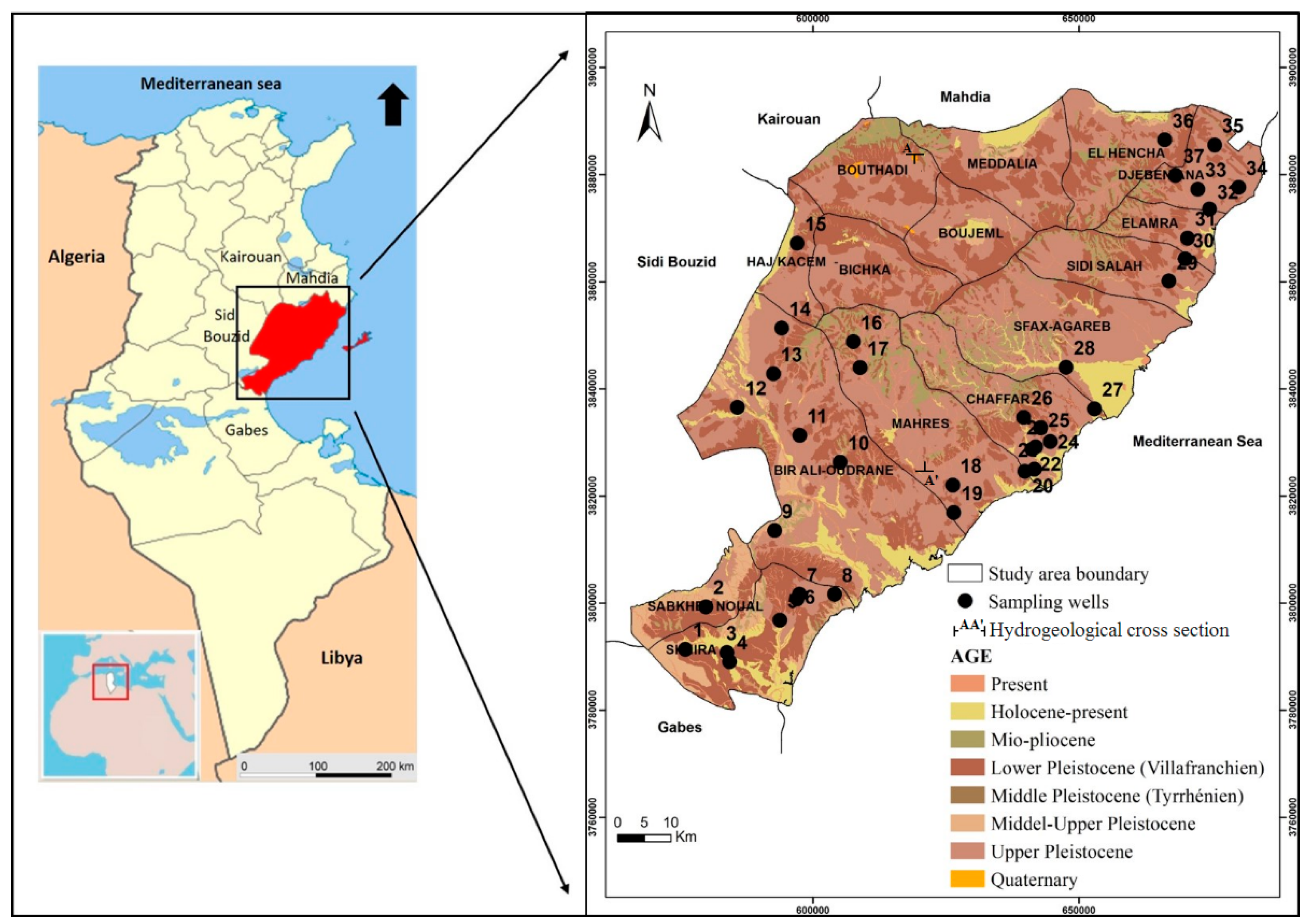
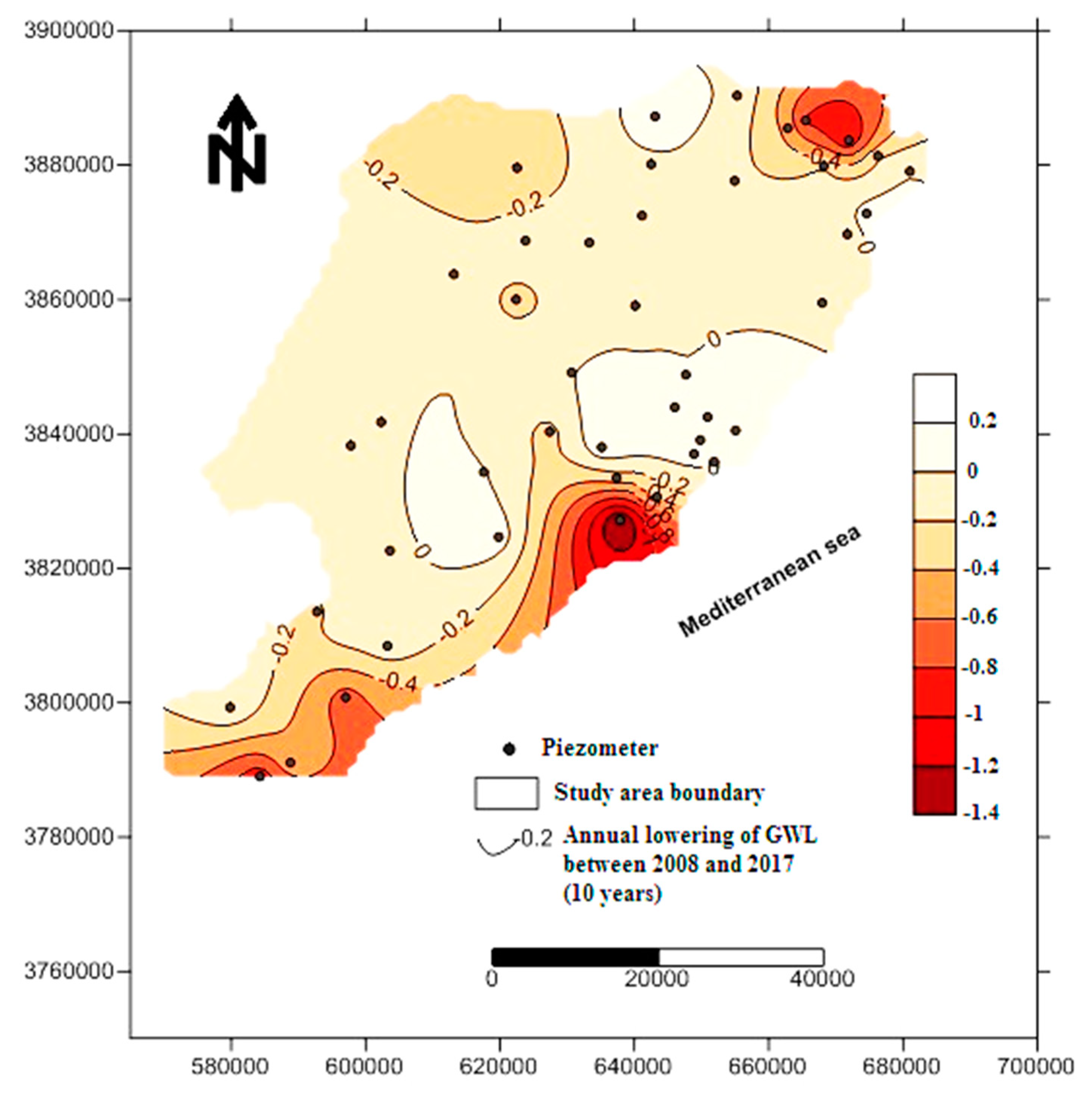
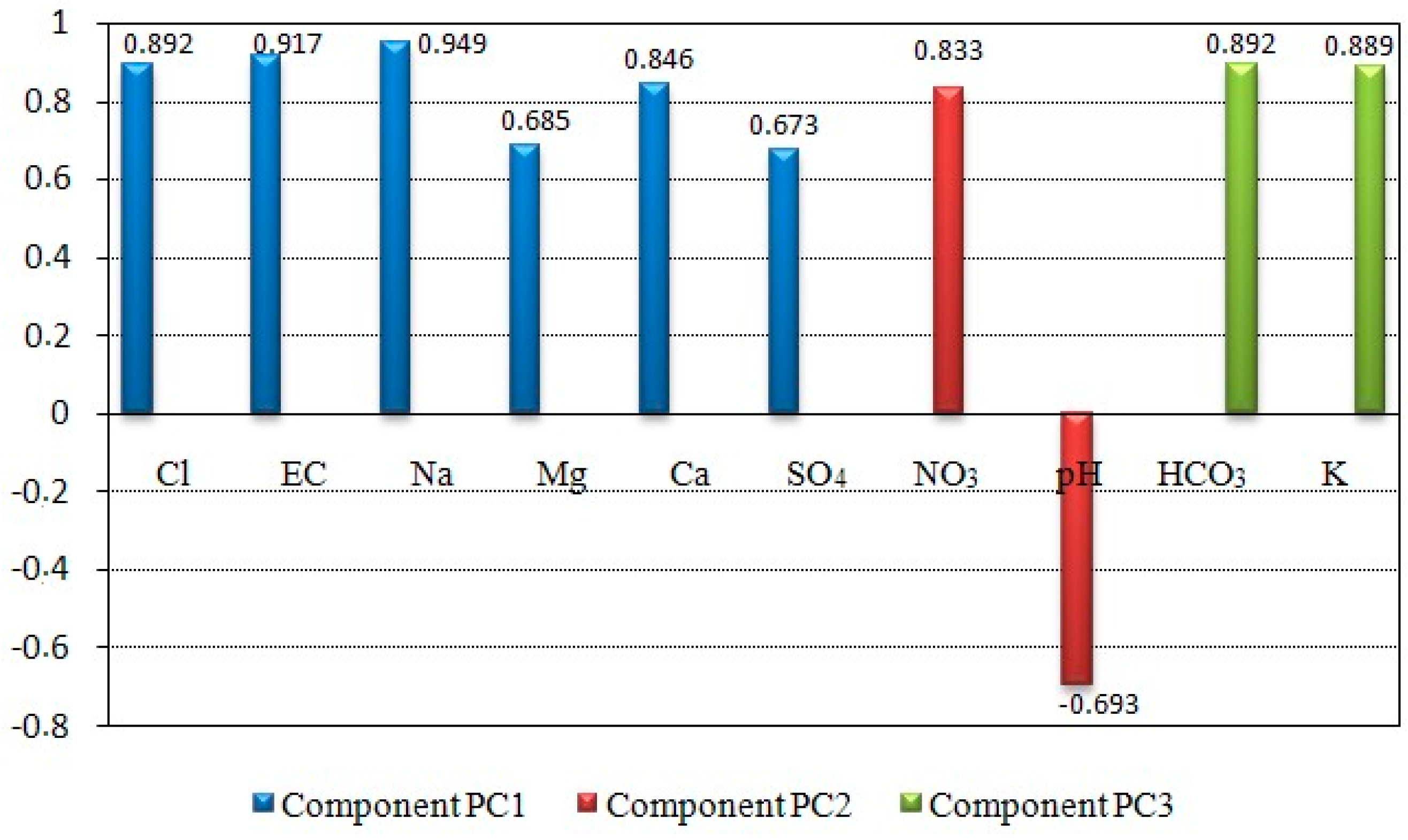
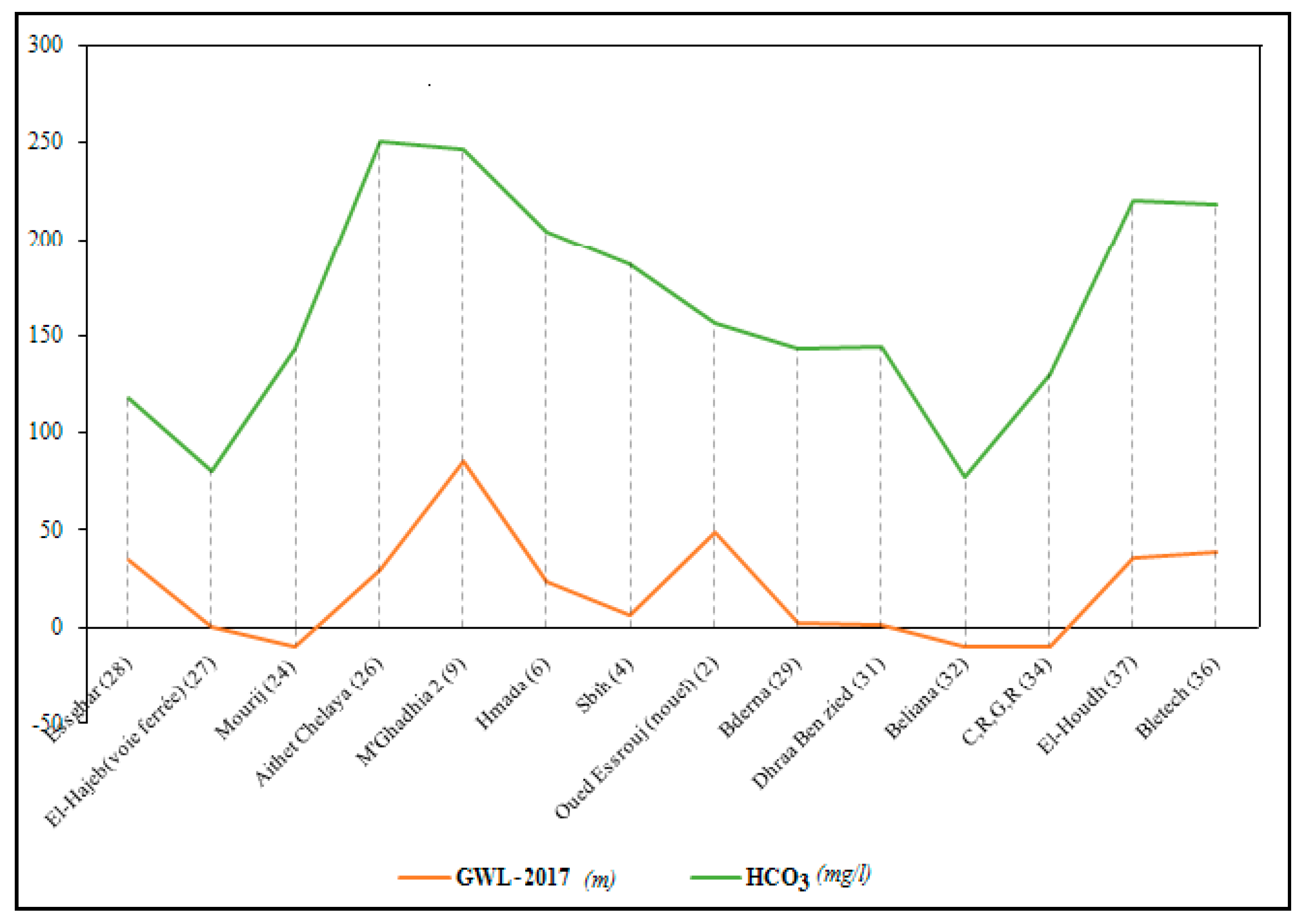
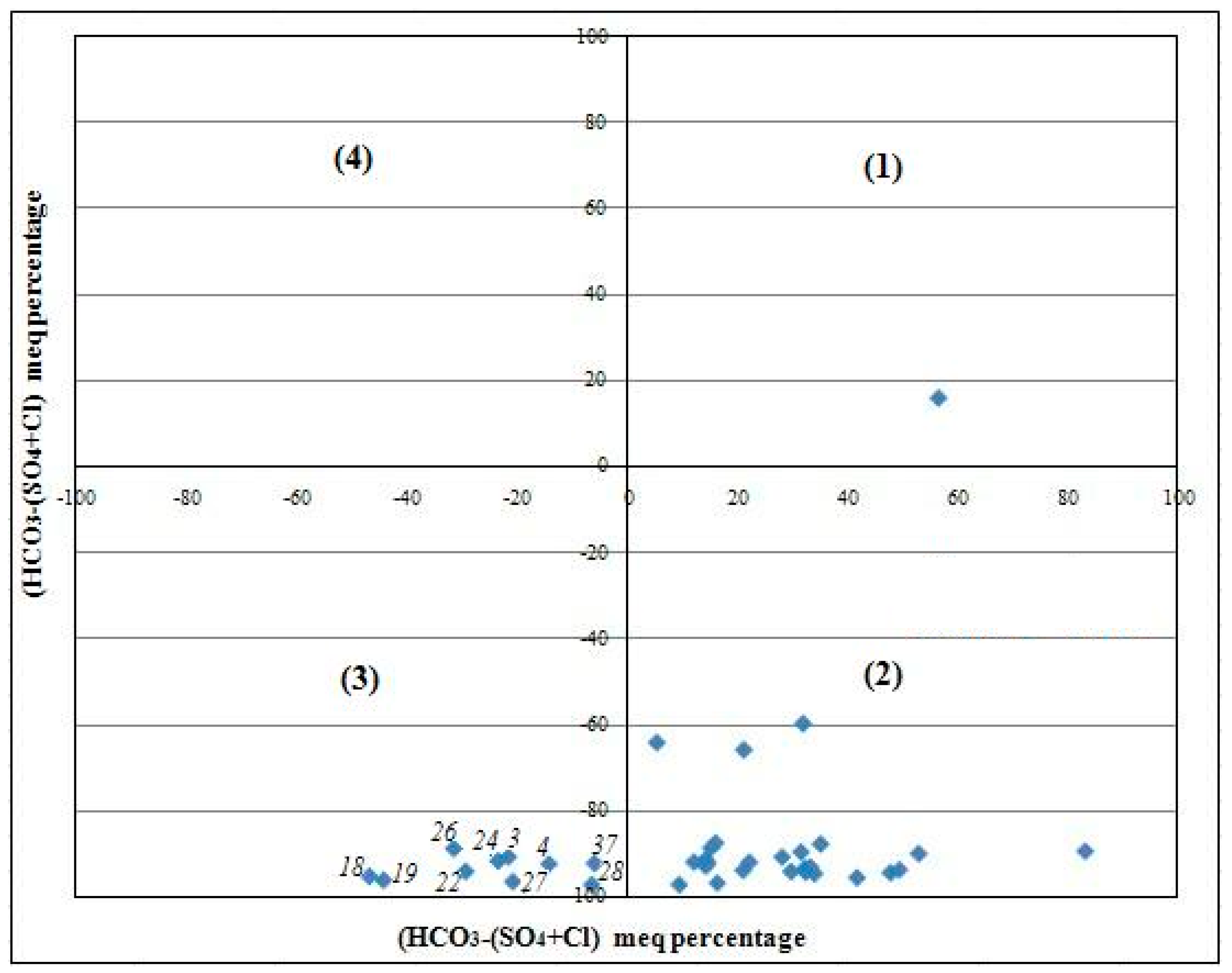
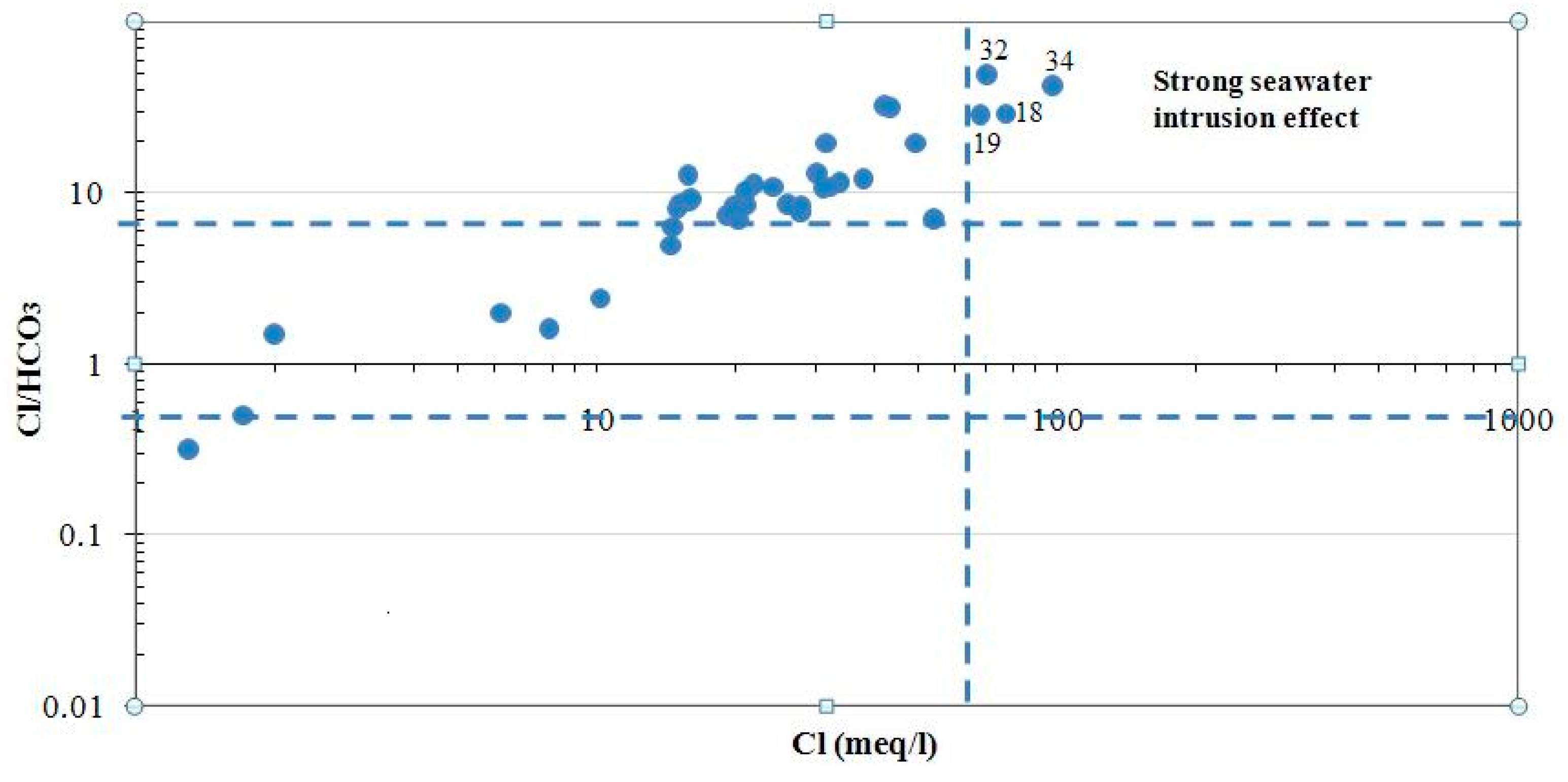
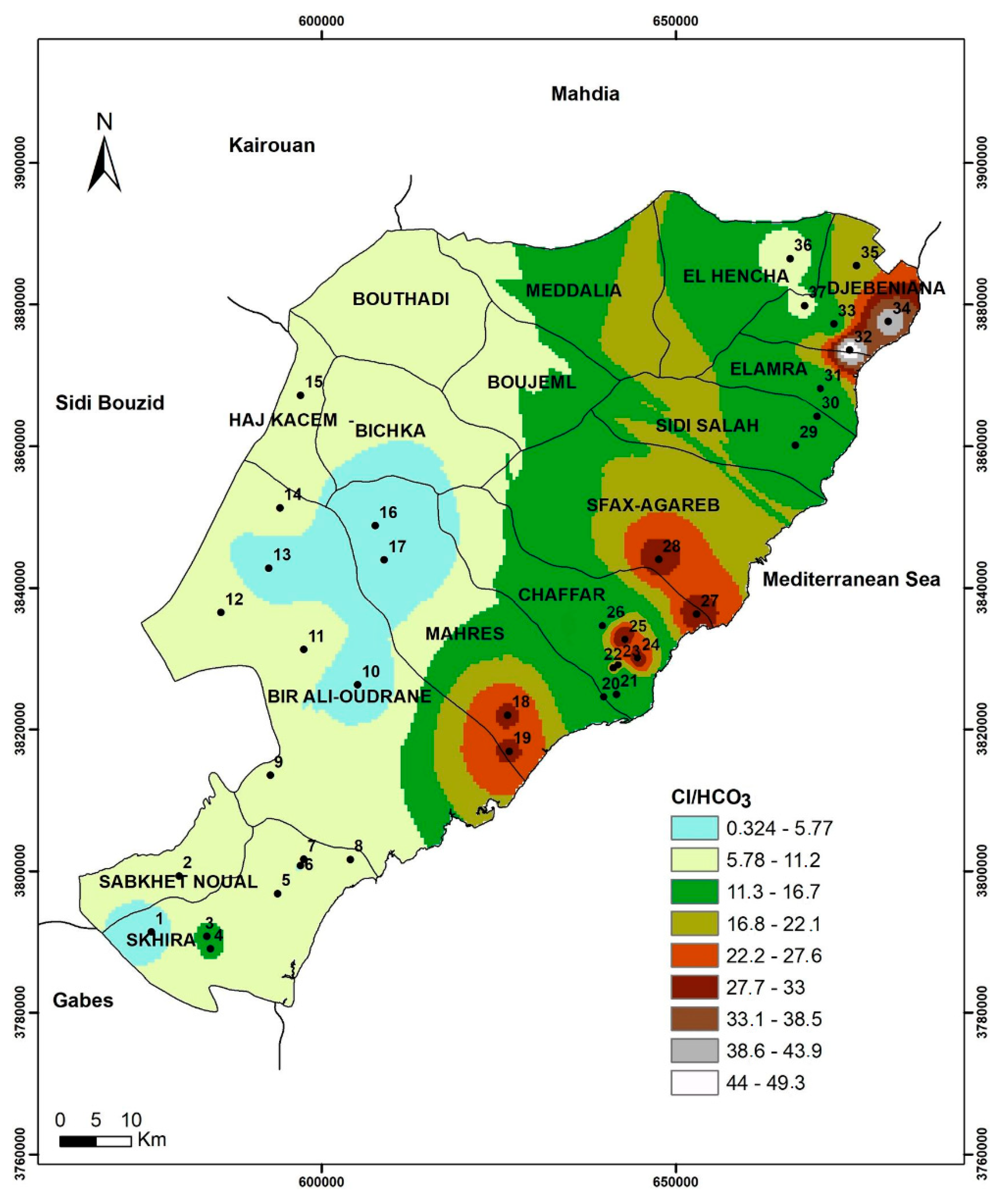
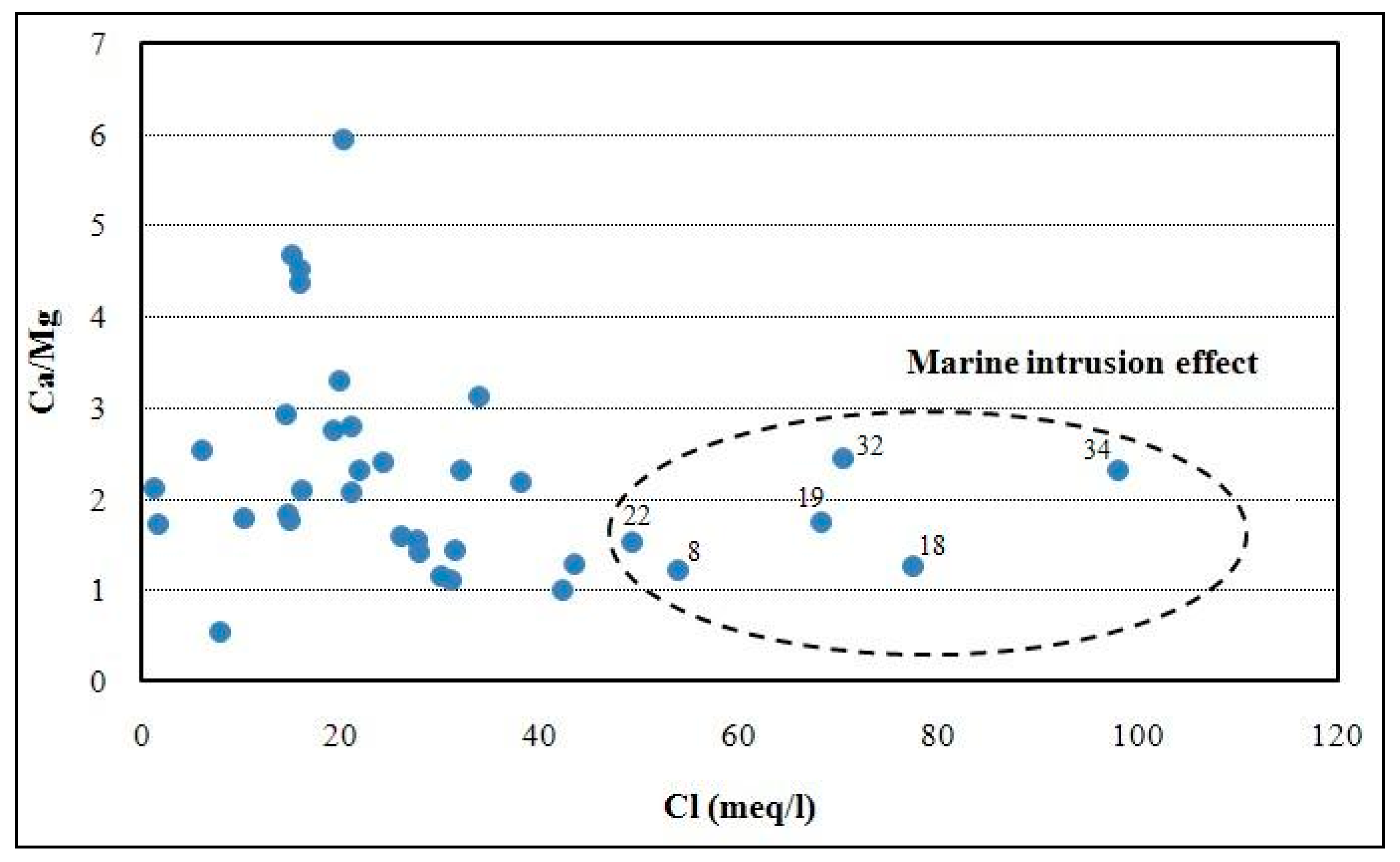
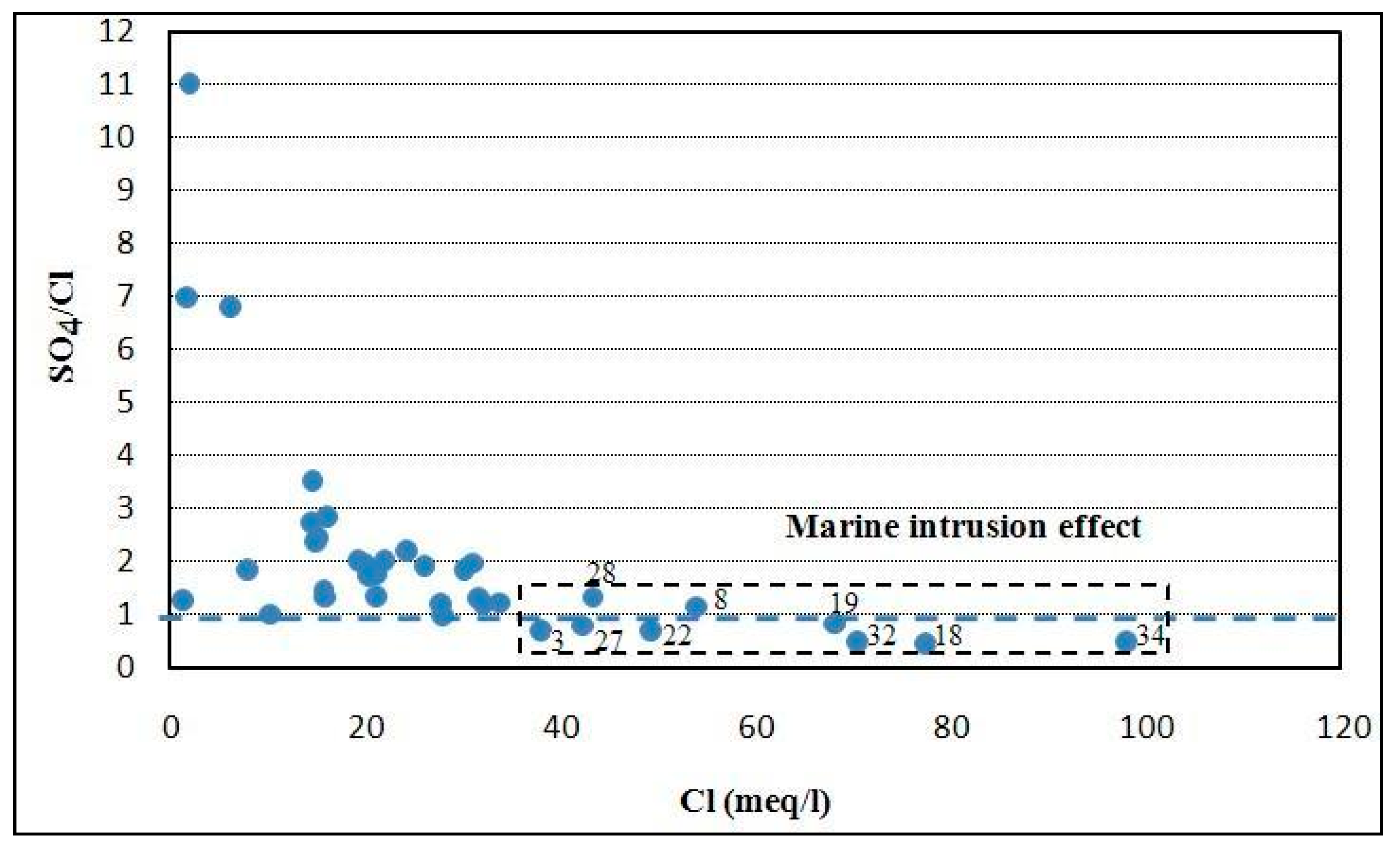
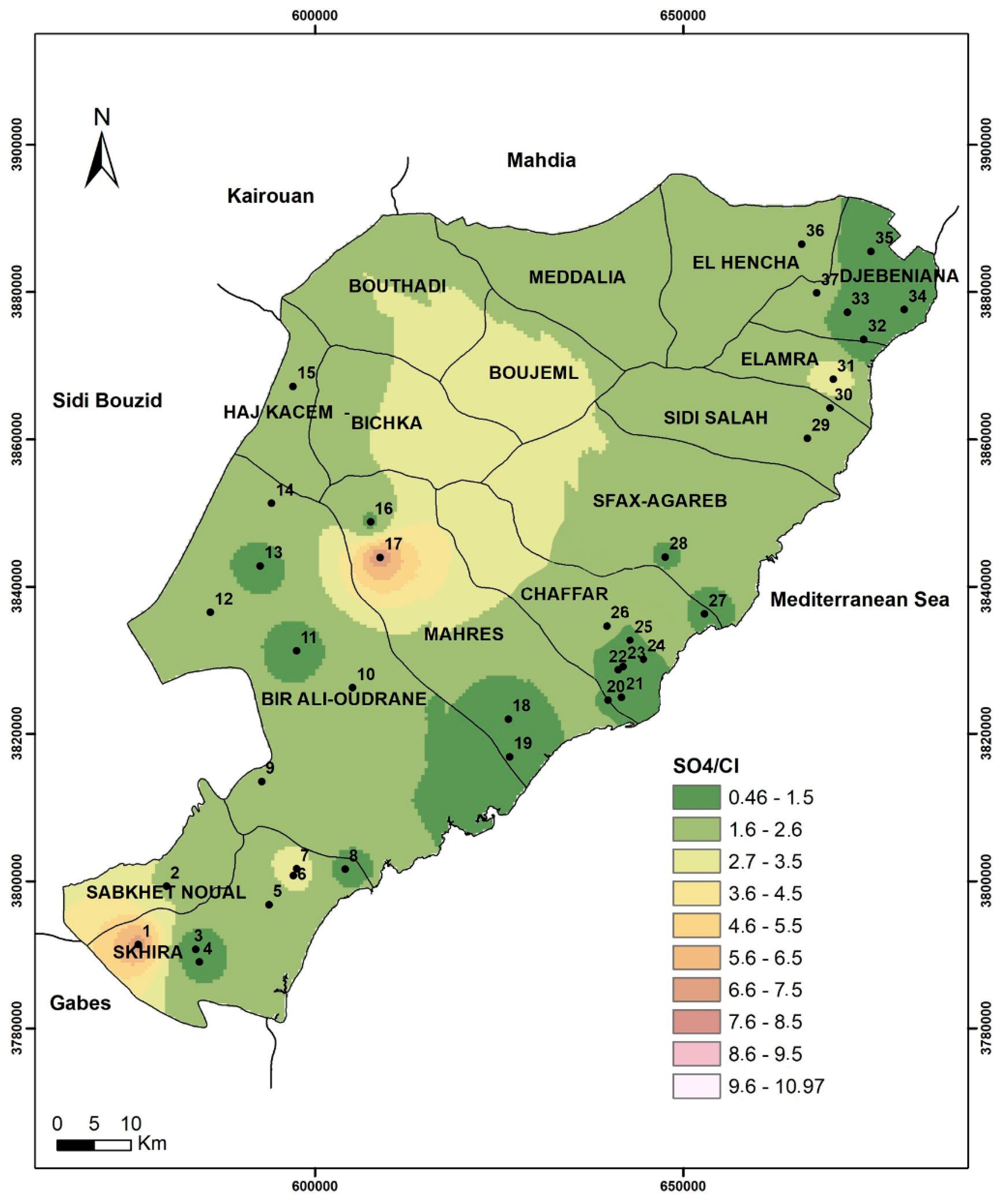
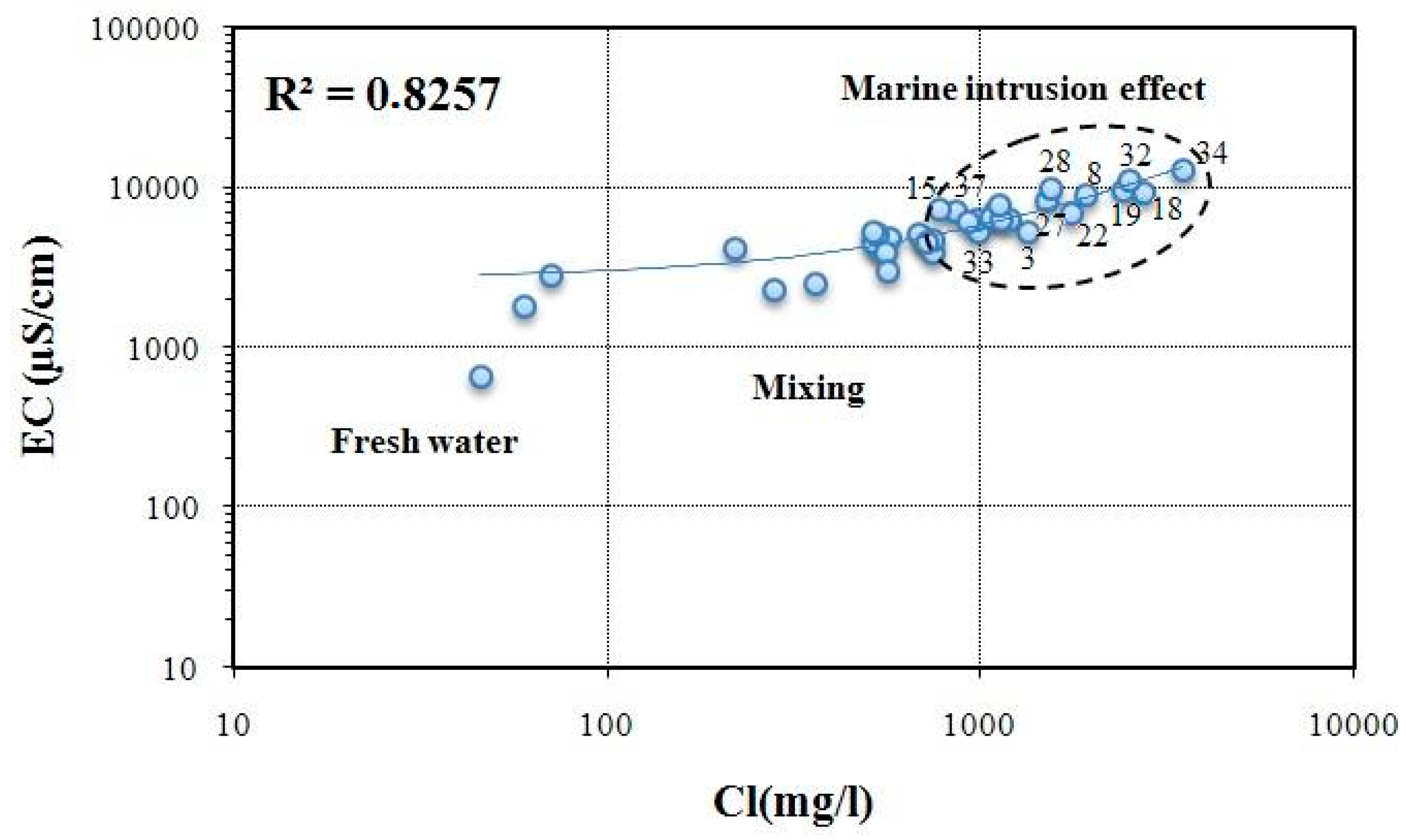
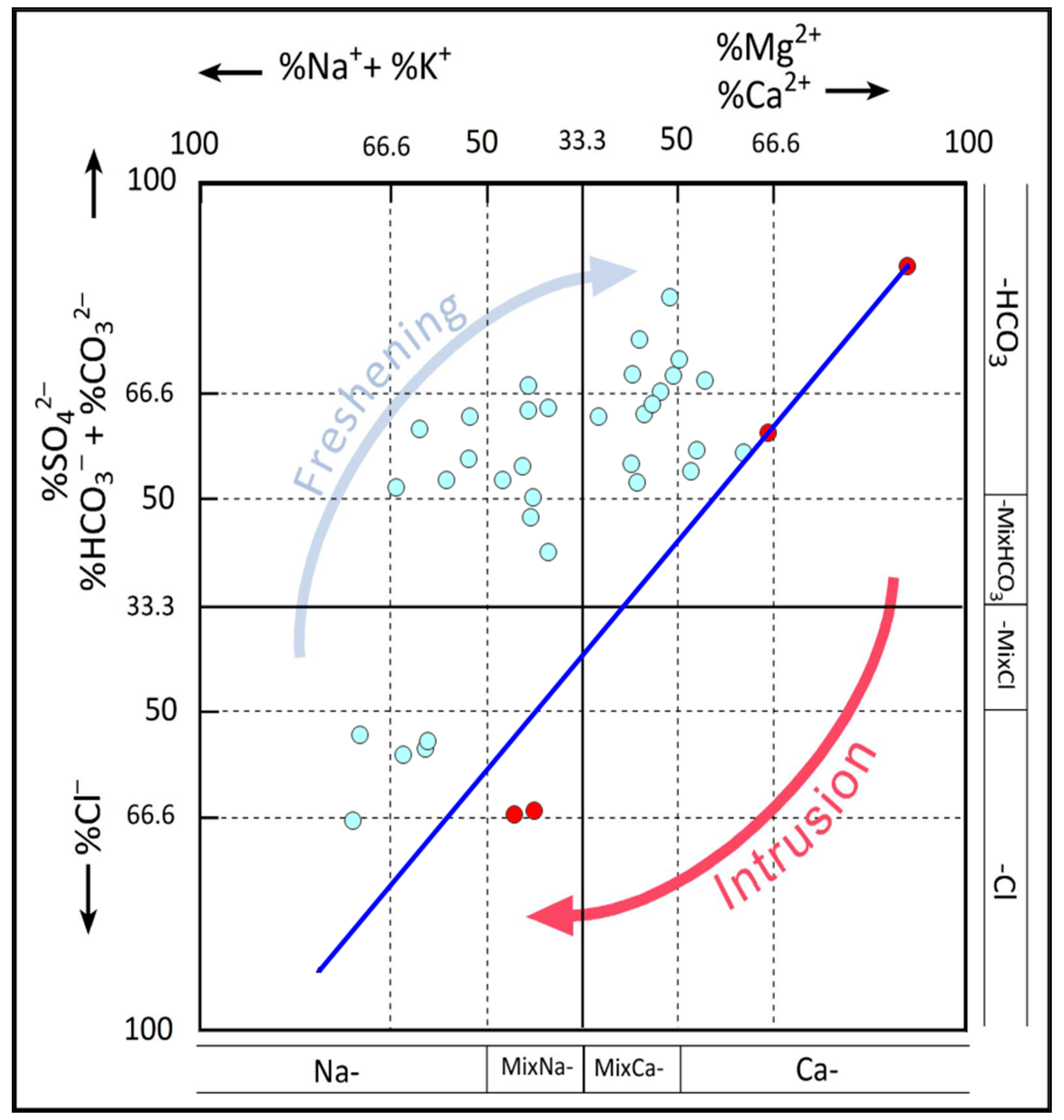
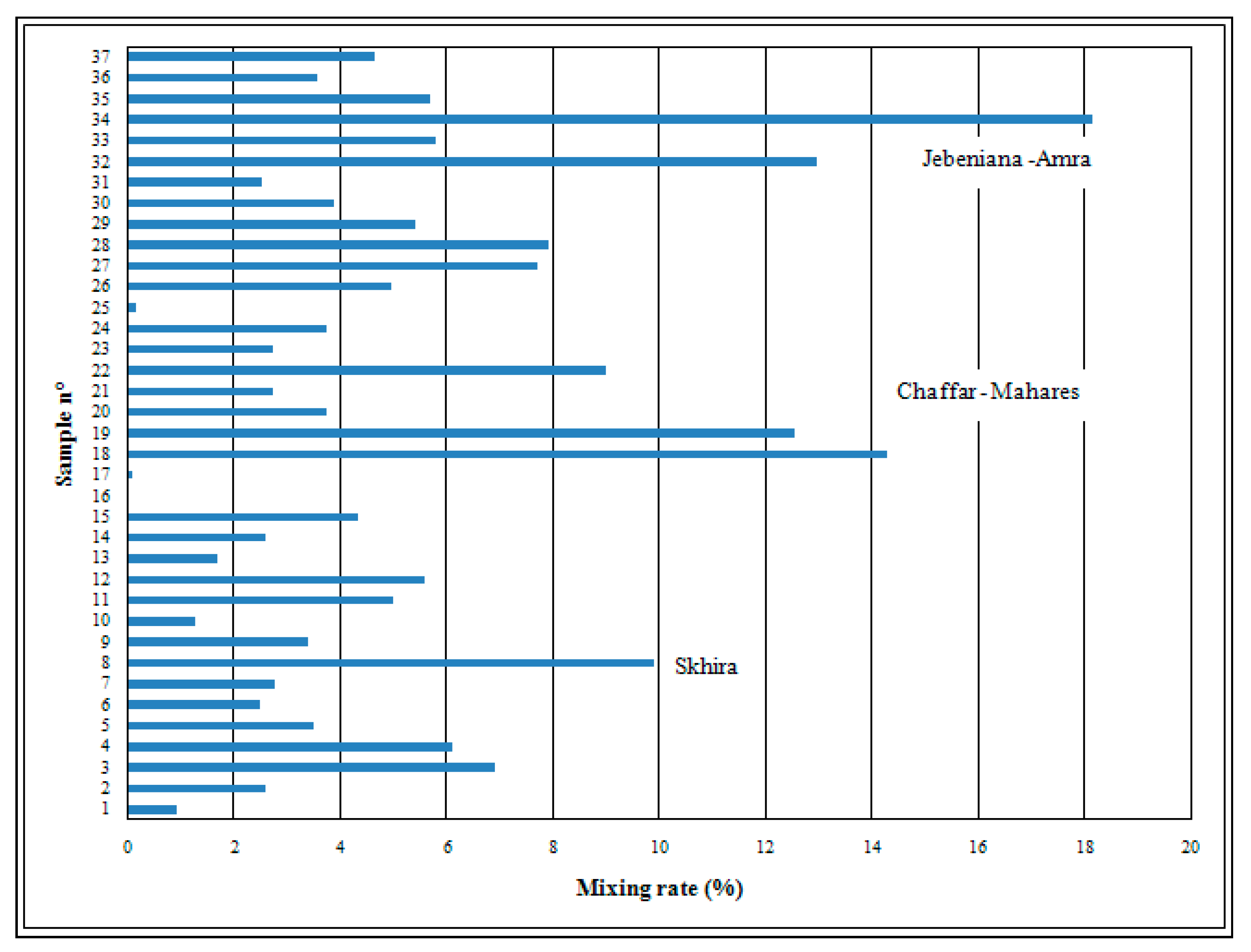
| N | Minimum | Maximum | Mean | Std. Deviation | |
|---|---|---|---|---|---|
| pH | 37 | 6.33 | 7.89 | 7.39 | 0.352 |
| EC (μS/m) | 37 | 6.6 × 102 | 1.3 × 104 | 5.8 × 103 | 2.6 × 103 |
| Na | 37 | 3.2 × 10 | 2.3 × 103 | 7.7 × 10 | 5.3 × 102 |
| Mg | 37 | 6.50 | 3.8 × 102 | 1.6 × 102 | 9.5 × 10 |
| Ca | 37 | 9.0 × 10 | 1.4 × 103 | 5.4 × 102 | 2.4 × 102 |
| NO3 | 37 | 4.00 | 1.6 × 102 | 4.5 × 10 | 3.0 × 10 |
| SO4 | 37 | 8.1 × 10 | 3.0 × 103 | 1.8 × 103 | 7.0 × 102 |
| HCO3 | 37 | 7.5 × 10 | 4.7 × 102 | 1.6 × 102 | 7.4 × 10 |
| Cl | 37 | 4.6 × 10 | 3.5 × 103 | 1.0 × 103 | 7.8 × 102 |
| K | 37 | 1.70 | 62.00 | 14.50 | 10.61 |
| Component | |||
|---|---|---|---|
| PC1 | PC2 | PC3 | |
| pH | −0.176 | −0.693 | −0.113 |
| EC | 0.917 | 0.354 | −0.027 |
| Na | 0.949 | −0.080 | −0.040 |
| Mg | 0.685 | 0.392 | 0.380 |
| Ca | 0.846 | 0.387 | −0.018 |
| SO4 | 0.673 | 0.412 | 0.216 |
| NO3 | 0.072 | 0.833 | −0.011 |
| Cl | 0.892 | 0.240 | −0.030 |
| HCO3 | −0.074 | −0.172 | 0.892 |
| K | 0.157 | 0.290 | 0.889 |
| Borehole No. | Phase | Facies | |
|---|---|---|---|
| Cations | Anions | ||
| 1 | Fresh | MixCa | SO4 |
| 2 | Fresh | Ca | SO4 |
| 3 | Fresh | Na | Cl |
| 4 | Fresh | Na | SO4 |
| 5 | Fresh | MixCa | SO4 |
| 6 | Fresh | MixCa | SO4 |
| 7 | Fresh | Ca | SO4 |
| 8 | Fresh | MixNa | SO4 |
| 9 | Fresh | MixNa | SO4 |
| 10 | Fresh | MixNa | SO4 |
| 11 | Fresh | MixNa | MixSO4 |
| 12 | Fresh | MixNa | SO4 |
| 13 | Fresh | MixNa | MixSO4 |
| 14 | Fresh | MixNa | SO4 |
| 15 | Fresh | MixCa | SO4 |
| 16 | Fresh | Ca | HCO3 |
| 17 | Fresh | MixCa | SO4 |
| 18 | Fresh | Na | Cl |
| 19 | Fresh | Na | Cl |
| 20 | Fresh | MixNa | SO4 |
| 21 | Fresh | Ca | SO4 |
| 22 | Fresh | Na | Cl |
| 23 | Fresh | Ca | SO4 |
| 24 | Fresh | Na | SO4 |
| 25 | Intrus | Ca | SO4 |
| 26 | Fresh | Na | SO4 |
| 27 | Fresh | Na | Cl |
| 28 | Fresh | Na | SO4 |
| 29 | Fresh | MixCa | SO4 |
| 30 | Fresh | MixCa | SO4 |
| 31 | Fresh | MixCa | SO4 |
| 32 | Intrus | MixNa | Cl |
| 33 | Fresh | MixCa | SO4 |
| 34 | Intrus | MixNa | Cl |
| 35 | Fresh | MixCa | SO4 |
| 36 | Intrus | Ca | SO4 |
| 37 | Fresh | Na | SO4 |
| Rmix (%) | Boreholes | City | Seawater Intrusion Risk |
|---|---|---|---|
| 20–15 | 34 | Jebeniana | Very high |
| 15–10 | 18, 19, 32 | Jebeniana–Mahares– Chaffar | High |
| 10–5 | 3, 4, 8, 12, 22, 28, 29, 27, 33, 35 | Skhira–jebeniana–Agareb–Chaffar | Medium |
| 5–0 | The rest of samples | Inland area | Low |
Publisher’s Note: MDPI stays neutral with regard to jurisdictional claims in published maps and institutional affiliations. |
© 2021 by the authors. Licensee MDPI, Basel, Switzerland. This article is an open access article distributed under the terms and conditions of the Creative Commons Attribution (CC BY) license (https://creativecommons.org/licenses/by/4.0/).
Share and Cite
Hajji, S.; Allouche, N.; Bouri, S.; Aljuaid, A.M.; Hachicha, W. Assessment of Seawater Intrusion in Coastal Aquifers Using Multivariate Statistical Analyses and Hydrochemical Facies Evolution-Based Model. Int. J. Environ. Res. Public Health 2022, 19, 155. https://doi.org/10.3390/ijerph19010155
Hajji S, Allouche N, Bouri S, Aljuaid AM, Hachicha W. Assessment of Seawater Intrusion in Coastal Aquifers Using Multivariate Statistical Analyses and Hydrochemical Facies Evolution-Based Model. International Journal of Environmental Research and Public Health. 2022; 19(1):155. https://doi.org/10.3390/ijerph19010155
Chicago/Turabian StyleHajji, Soumaya, Nabila Allouche, Salem Bouri, Awad M. Aljuaid, and Wafik Hachicha. 2022. "Assessment of Seawater Intrusion in Coastal Aquifers Using Multivariate Statistical Analyses and Hydrochemical Facies Evolution-Based Model" International Journal of Environmental Research and Public Health 19, no. 1: 155. https://doi.org/10.3390/ijerph19010155
APA StyleHajji, S., Allouche, N., Bouri, S., Aljuaid, A. M., & Hachicha, W. (2022). Assessment of Seawater Intrusion in Coastal Aquifers Using Multivariate Statistical Analyses and Hydrochemical Facies Evolution-Based Model. International Journal of Environmental Research and Public Health, 19(1), 155. https://doi.org/10.3390/ijerph19010155








